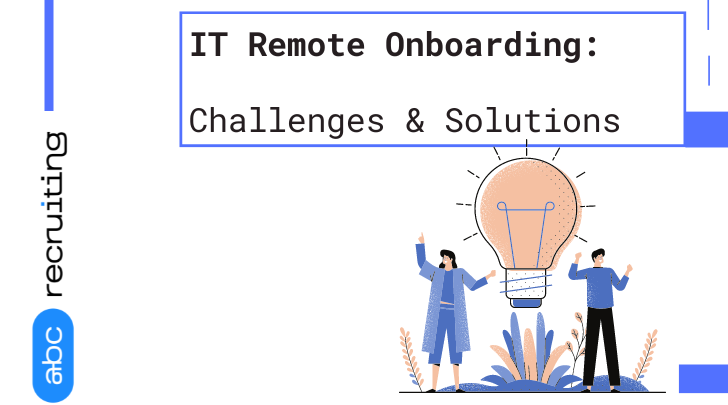You’re about to make a decision that could change your company’s future. You need to bring on the perfect IT professional remotely, but you’re apprehensive. How do you go about onboarding someone remotely? Can you make sure that they feel just as connected and supported as they would in an in-person setting?
Remote onboarding brings with it plenty of challenges, but solutions are possible with the right guidance. At ABC Recruiting Inc., we know what it takes to successfully bring on potential new hires remotely. In this blog post, we’ll be discussing these challenges and solutions so that you have all the information you need.
Overview of the IT Remote Onboarding Process
When running a business with employees who work remotely, IT remote onboarding presents unique challenges. This process includes essential tasks for new staff, such as providing access to software applications and resources, setting up pre-defined systems and services, and understanding key policies and procedures.
The goal of successful remote onboarding is to ensure that new IT staff have the knowledge and support they need to work productively. Without face-to-face interaction, it can be difficult to provide newcomers with the same level of personal guidance and expertise they may have experienced in an office environment.
IT organizations must take time to understand the specific challenges posed by remote onboarding and create tailored solutions that will make the process smoother. This can include a range of activities such as providing training materials, connecting with peers in remote offices, initiating virtual meetings between managers or mentors and new staff members, hosting “virtual parties” for introductions between colleagues; or creating “welcome packages” that cover key topics related to working remotely.
Challenges of IT Remote Onboarding
You've just finished onboarding a team of IT professionals remotely—but did you really achieve success? The process brings its own unique challenges, and if they aren't addressed, it can be difficult to set your employees up for success.
The first challenge is how to keep employees engaged. Without the benefit of face-to-face interactions, it can be difficult for employees to stay motivated. Furthermore, with remote onboarding, it's very easy for employees to become overwhelmed or confused, as they don't have access to mentors or colleagues who know the ropes.
Other challenges include a lack of transparency in communication, difficulty coordinating across different departments and systems, and little control over the pace and sequence of tasks. Finally, some companies find it difficult to provide the necessary access rights and permissions during remote onboarding—especially when dealing with complex IT infrastructure.
These challenges may seem daunting—but with careful planning and strategic solutions like cloud-based collaboration tools, you can make sure that your IT remote onboarding process is smooth and successful.
Tips for Successful IT Remote Onboarding
When it comes to successful IT remote onboarding, there are a few tips you can keep in mind. First and foremost, the process should be well-defined, with each step of the process outlined and discussed with the new hire before they start working.
This is especially important for remote work. Without face-to-face contact, it can be hard to tell when your new team member is having difficulties understanding what’s expected of them. Also, having milestones helps hold both parties accountable and keeps everyone on track.
The following are some tips for successful remote onboarding:
- Create an onboarding plan that outlines the essential steps for success
- Ensure a positive and productive first day by setting realistic expectations about tasks and timeline
- Connect with your new hire regularly to check on their progress
- Provide frequent feedback to both celebrate successes and address any areas of improvement
- Make sure all necessary tools, such as software and web services, are available ahead of time
- Establish a schedule for regular check-ins with your new hire
- Allow time for any technical issues that may arise during remote onboarding
- Make sure your team feels part of the team by including them in social activities or virtual happy hours
By following these steps during IT remote onboarding you can ensure a smooth process that will leave both you and your new hire feeling successful in their integration into the company!
Technology and Tools Needed for IT Remote Onboarding
One of the biggest challenges faced when it comes to IT remote onboarding is getting the right technology and tools in place so that employees can work efficiently while they’re offsite. Remote teams need access to the same resources and technology that on-site employees use, including hardware, software, and communication platforms.
Hardware
When it comes to IT remote onboarding, hardware is particularly important. It’s essential that each employee has access to the appropriate hardware for the tasks they need to do. For example, if a company regularly uses specific software programs or applications for its work processes, then each employee should have their own laptop or desktop with these programs installed.
Software
A company also needs to make sure its employees are using the same software versions for consistency across all of its operations. This ensures team members don’t run into compatibility issues between one another’s machines due to different versions of software being used. The company should also make sure that it has a secure network in place that allows its remote workers safe access to its sensitive data and documents while they’re working offsite.
Communication Platforms
In order for remote teams to collaborate effectively, they need a secure communication platform where they can chat with one another and stay on top of tasks easily. It’s important that companies invest in a good communication platform with features like task management and file-sharing capabilities so their remote workers are always in sync with each other and up-to-date on project statuses.
Conclusion
As the IT industry continues to expand, the need to hire and onboard remote employees grows with it. It can be difficult to embrace the challenges of onboarding new employees virtually, and staying on top of up-to-date technology and practices can be a challenge.
However, with the right tools and processes in place, IT companies have the ability to create smooth and successful remote onboarding experiences. By leveraging resources to support remote onboarding, IT companies can reduce the anxiety of onboarding, boost employee engagement, and ultimately increase performance.




